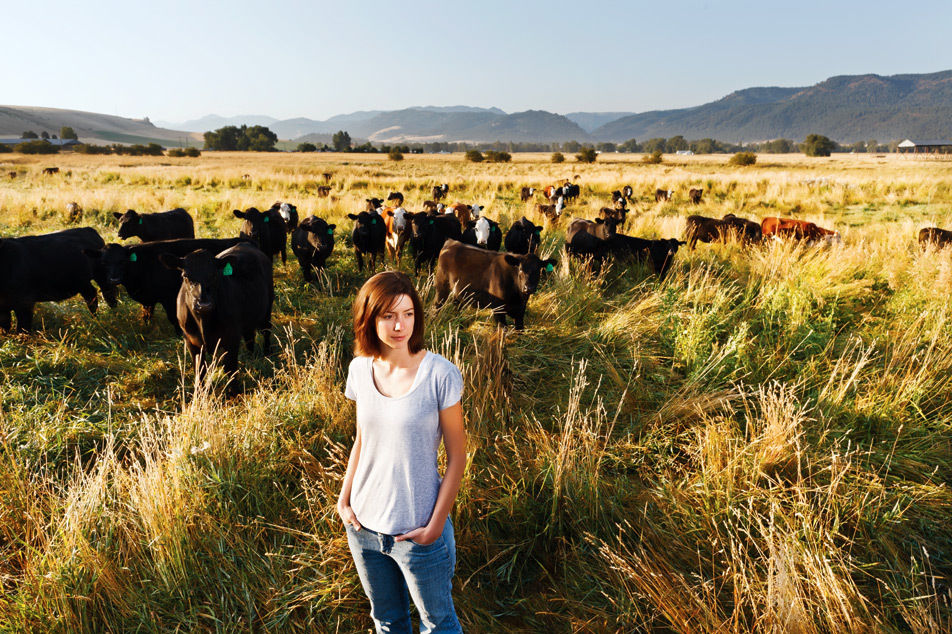
Greener Pastures
THE GRAND CENTRAL BAKERY on N Fremont Street may be best known for thick sandwiches and supple loaves of como and ciabatta. But on a hot Saturday afternoon in July, its parking lot has turned into a meat market as 32 customers line up before a spindly card table to pick up the pieces of nine cows. Doled out from the back of a freezer truck in vacuum-sealed, meal-size parcels of steaks, hamburger, and roasts, these quarters and sides of beef only days before were 2-year-old Black Anguses and Herefords wandering the pastures of Eastern Oregon’s Carman Ranch.
Statuesque, with dewy, unblemished skin, co-owner Cory Carman, 32, looks more like a Hollywood actress than a fourth-generation rancher. But dressed in a T-shirt and jeans, she greets each customer by name, asking after their children and offering tips for cooking unfamiliar cuts of beef like like tri-tip and arm roast. Nearby, three strapping men hunch over cardboard boxes, divvying up a side (a half a cow) they’ve bought together that will yield 100 pounds of meat for each. A 50-something man wearing flip-flops and shorts tells Carman that her timing is perfect: he and his wife just finished cooking up the last of a quarter cow purchased back in November. As Carman’s husband, Dave Flynn, hauls two boxes of beef to a nearby car, he asks drolly, “You didn’t want any organs?” The emphatic “No thanks!” draws a different buyer who quickly snaps up six free livers, soon to be minced and simmered, as he carefully notes, in olive oil and spices.
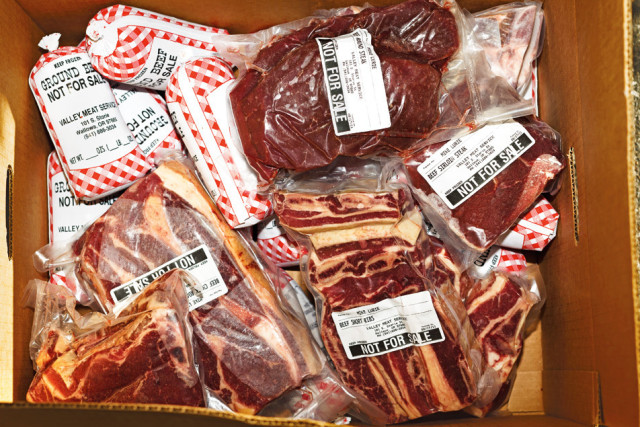
It’s the first delivery of the season for Carman Ranch’s flourishing “cow share” program. The 32 buyers on this day are among 300 members total in Portland, each paying between $500 and $600 per quarter animal. Carman has them slaughtered and butchered to her customers’ specifications, down to the steaks, lean ground beef, and boned short ribs. The $6-a-pound average for the hanging weight of the meat makes it more expensive than $4.50-a-pound hamburger at the Safeway two miles away but less than the supermarket’s $10.50-a-pound rib eye steak.
But price is just one consideration. “Until you taste it, you don’t have anything to compare it to,” says Clark Matschek, a landscape architect, who with wife Marsha Matschek, a horticulturist, wandered upon Carman Ranch as two of 2,000 cyclists pedaling by on a 2009 Cycle Oregon trip. “It’s leaner,” Clark adds. “It has a more complex flavor. Not a strong, gamey flavor, but a subtle, complex taste.”
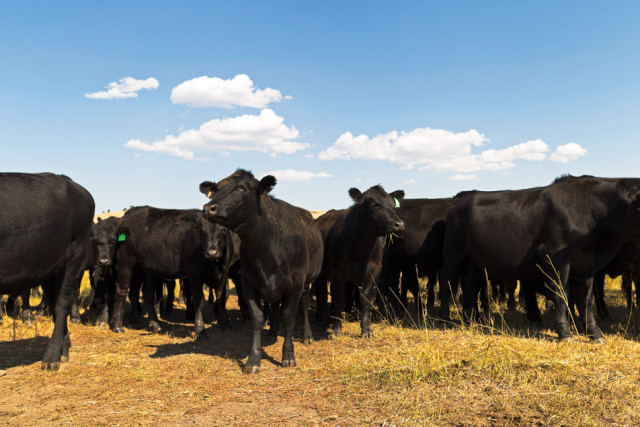
A three-year study conducted by Clemson University professor Susan Duckett in conjunction with the USDA showed grass-fed beef to be nutritionally superior to the corn-fed beef that now dominates the US market, with less saturated fat and more beta-carotene, omega-3 fatty acids, and another beneficial fat called CLA (conjugated linoleic acid), a potential cancer fighter. And when managed properly, grass-fed ranches also have a smaller carbon footprint than industrial feedlots do. The Union of Concerned Scientists recently released a report saying that pasture-based systems of beef production could reduce global greenhouse gas emissions by 140 million metric tons a year—equivalent, according to the EPA, to the annual emissions of 27.5 million cars.
Restaurants like Beast, Clarklewis, June, and Paley’s Place, and larger conscientious kitchens like Lewis & Clark College’s food provider, Bon Appetite, are all vying for Carman Ranch beef, too. Along with the Matscheks and other Portlanders willing to spend a summer Saturday loading their cars with hundreds of pounds of beef, most Carman Ranch buyers are in it for the flavor, the nutritional and ecological value, and, of course, the story.

Cory Carman and Dave Flynn load vacuum-sealed cuts of beef in Portland just days after the animals wandered Eastern Oregon pastures.
Eight years ago, Cory Carman literally bet the 8,000-acre family ranch on what then was both an ancient and a wildly experimental way of doing business: raising cows on the pasture and selling their meat directly to consumers. In the first three years, the task was finding profit—any profit—in the narrow margins of a few dozen cows. But now Carman Ranch takes its place in an increasingly crowded, complicated, and sometimes downright confusing marketplace. Labels can range from vague slogans of “sustainably raised” to highly specific pedigrees like Country Natural Beef’s new Pasture Raised line, in which the cows have “access to pasture” throughout their lives, but over their last 100 days are given a ration of corn, barley, hay, and potato slurry.
Now, with the prices spiking for conventionally raised beef and a well-heeled urban population eager to savor their way across the urban-rural divide, Carman faces a different challenge: scaling up to meet the demand while holding on to her ideals of delivering better beef in a more ecological and humane way. All while still saving the family ranch.
Waving a hand to the cow-share members lingering to divide up their orders, she says, “They know where their meat comes from and know the cows have never left the ranch. They’re eating whole animal quantities. This is totally representative of how our food system should be.”
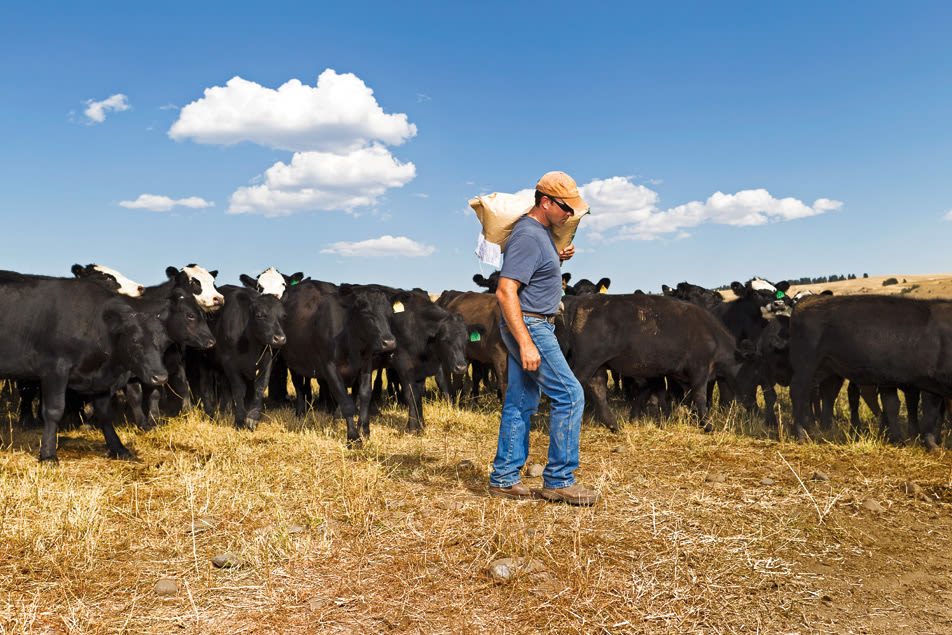
Dave Flynn carries a 50-pound bag of loose salt, which he’ll mix with trace minerals and leave out for the cattle.
Image: Daniel Root
THE DRIVE FROM La Grande northeast along Highway 82 traverses flat, green plains flecked with blink-and-you-miss-’em towns like Imbler and Elgin. But where the road cuts through the 2,500-foot Minam Canyon and begins to hug the Wallowa River, the landscape shifts. Just north of the hamlet of Wallowa (population 869), a lush valley unfolds that might easily be mistaken for an Alpine village in Switzerland, with swaying meadows blanketed in prairie grass and snowy summits piercing the clouds.
Cory Carman grew up here, where weak coffee is the norm, every election is decided in the Republican primary, and some ranchers quip that they keep their semiautomatic rifles around “just in case the government comes for my land.” When Carman was in high school in the ’90s, she recalls, “It was like, ‘Are you an environmentalist or are you a normal person?’” Ranchers, on the other hand, were “cool.”
With a fat scholarship to Stanford University in 1997 and a burgeoning interest in the larger issues of food production, Carman soon found herself caught between those polarizing identities—and, ironically, enrolled in the environmental policy program. A rare creature raised around the challenges of both preserving and working the land, Carman still winces at the memory of how a professor shot down her ethics paper on the spotted owl. (She’d argued that the Endangered Species Act can encourage the destruction of habitat.) It was there she encountered her first vocal critique of ranching, primarily aimed at the industrial-scale beef production facilities known as confined animal feeding operations (CAFOs). “Everyone was a vegetarian, and everyone hated cattle because they were ruining the environment,” she says. “They were appalled at what we do.”
Initially, Carman didn’t comprehend the criticism. Her father, uncle, grandfather, and great-grandfather (Fritz Weinhard, Henry’s great-nephew) had always grazed their cattle on open pasture most of the year. During Wallowa’s bitter winter, the cattle moved indoors, into concrete bunkers where they ate a mix of hay, grain, and corn rations laced with protein supplements. In the spring, her family sold them at a livestock auction on the open market. “We never thought about where they went,” says Carman. The CAFOs that her classmates despised were so remote from her experience of ranching that she naively had failed to realize that her family had been indirectly supplying them with cattle for decades.
But one day driving to LA through the San Joaquin Valley, Carman got a whiff of the side of meat production that had turned her classmates vegetarian. “It smelled like something dead on the side of the road,” she says. For miles, she couldn’t figure out what the ripe stench was. But then she saw it: a veritable metropolis of cattle, over a hundred thousand of them packed together as far as the eye could see. It was Harris Cattle Ranch, the largest and most infamous feedlot on the West Coast. Carman found herself so mesmerized by the sight that she nearly drove off the road. “I had no idea this existed,” she says. “I said to myself, ‘This is what everybody eats.’”

In the winter, the cows’ grass diet is supplemented with hay.
The experience inspired a new mission: to prove to her classmates (and to herself) that beef did not have to be produced on the feedlot. Her grandparents in the ’30s and ’40s had done it. Ranchers in Argentina and New Zealand did it now. With a green light from her adviser and food economics professor, Wally Falcon (himself the product of a small farm), Carman tackled a work-study research project on grass-fed beef, staying on for three months after graduation to complete it. She found only 50 ranches in the US even attempting the method, many with mixed results. An uncle, Hoy Carman, a professor of agricultural economics at the University of California–Davis, soundly pooh-poohed the idea. (He had tried grass-fed beef while visiting New Zealand and found it inconsistent.) But for Carman, the research project produced a “retirement fantasy.”
“I’m going to do policy work,” she told herself, “but then, I’m going to come back to raise grass-fed beef.”
After a stint in Washington, DC, working for the House Ways and Means Committee in 2001—through both the September 11 attacks and subsequent anthrax terrorism mailings to federal offices—and a brief stop in Los Angeles managing a Japanese “comfort food” restaurant, the 23-year-old found herself pining for the untamed beauty of Eastern Oregon. In 2003, she headed home, only to discover her family ranch was on the edge of bankruptcy.
Carman’s father, Garth, died in a ranching accident when she was 14. In the decade since, her uncle Kent Carman had held everything together, running the operation exactly as her father had: growing wheat, barley, and oats and selling it, typically 1,800 tons, on the commodities market; buying a mix of corn, protein, and grain back to feed his cows; and, when they were 2, selling them at the spring livestock auction. But by the late ’90s, the profit margins had narrowed dramatically due to increasing competition from operations 20 times larger than Carman Ranch. Soon, the rising cost of nitrogen-based fertilizer and herbicides coupled with lower grain yields and a dive in grain and beef prices had sent the ranch spiraling to losses of $40,000 a year. Her uncle tried everything, lowering his inventory of cattle and applying for federal farming subsidies. But, according to Carman, “It was clear where the ranch was going.”
Looking back, Carman concedes her naiveté. She had written a college research paper on grass-fed ranching. She had begun seeing articles about the method in popular magazines. And one sleepless night, after poring over the ranch’s books, she simply guessed, “The time for this might be now.”
Her Uncle Kent was as skeptical as his brother at UC-Davis. “If you want to do something different,” he suggested, “what about beef jerky? That’s something people like.”
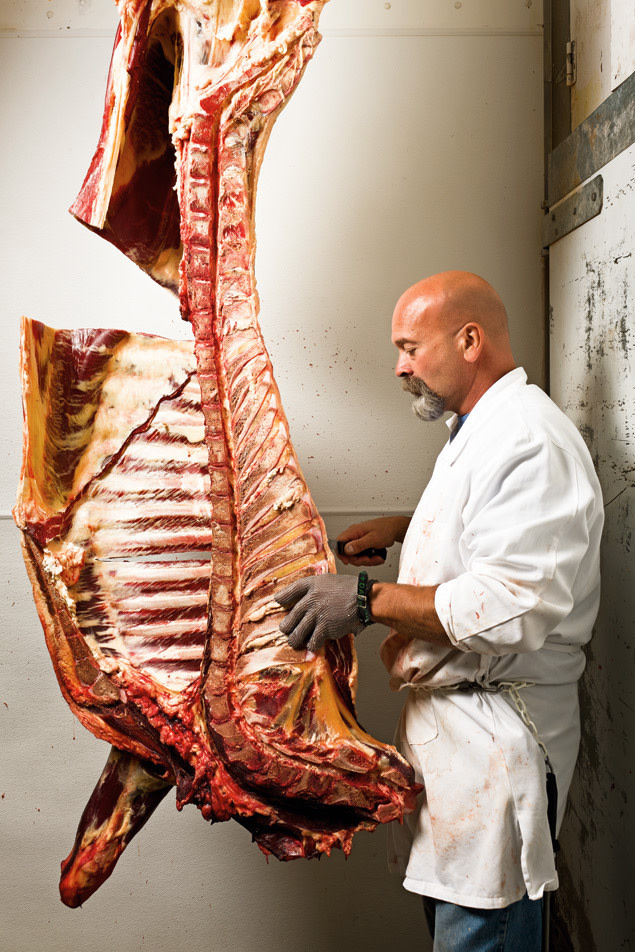
Butcher Kevin Silveira, a former logger, is now a vital part of Carman’s supply chain.
DAVE FLYNN is a ruggedly handsome outdoorsman with a passion for fly-fishing. Friends introduced him to Cory Carman in the summer of 2003, and he took an instant shine to the idealistic young Stanford grad. But a summer of wooing had left him without so much as a phone number. “The last thing I was gonna do,” Carman chuckles now, “was date a Wallowa County guy.”
Flynn worked as a river outfitter on the Grand Ronde, but he also managed 70 cattle for an absentee landowner from Seattle who had grown intrigued with the idea of raising grass-fed beef. And in the first two cows he had grazed entirely in the pasture, Flynn discovered a passport to his first date: he invited Carman to the slaughterhouse to drop off the cows and bring home his first grass-fed steaks.
Carman remembers being touched by Flynn’s tears over the final phase of animal husbandry. “But, me, the pragmatist,” she says, “I’m like, ‘They had a great life. I’m really curious to try this meat.’” She might have been readying to bet the family farm on grass-fed meat, but she had never even eaten it.
The slaughterhouse date quickly evolved into a business—and a family. Through Oregon State University the couple took “Ranching for Profit” courses, run by Stan Parsons, a pioneer of holistic range management, and got a crash course in raising grass-fed beef working for Flynn’s boss. The following year, 2004, they sold their first grass-fed cattle locally at the La Grande farmers market and launched their cow-share program in Wallowa and Union Counties. By spring 2006, with their first son, Roan, a toddler and twins soon to come, they started selling at the PSU Portland Farmers Market. It proved the perfect advertisement for expanding the cow-share (which she also calls their “custom program”) to Portland that same year, delivering the first 10 cattle to Portlanders in a rented U-Haul.
That year, Michael Pollan’s The Omnivore’s Dilemma landed with a splash. A best seller and a game changer for the nation’s food politics, it is in part a paean to small-scale operations like Polyface Farm, run by “grass farmer” Joel Salatin in Swoope, Virginia. “It went from us literally having to explain to people why grass-fed was important, this five-minute consumer education spiel,” recalls Carman, “to people coming up to us and saying, ‘I know what you’re doing. I think it’s so important….’” Sales leapt at the market and in the cow-share program.
In 2009, Bon Appetite Management Company put in an order for 15 cows for Lewis & Clark College. The following year, Oregon Health & Science University and several high-end restaurants bought a total of 150 cows. Soon after, Carman quit selling any animals to the commodity market. Today, she jokes, “We ought to send Michael Pollan a thank-you note.”
Even Uncle Kent has become a fan, of sorts. A man of few words who prefers his steaks with ketchup, he long refused to try the ranch’s new grass-fed beef for fear of not liking it. But after Carman got Wallowa’s local burger joint to switch to the ranch’s beef, her uncle is now a regular—three times or more a week.
“I am impressed,” says Kent Carman of the meat’s flavor even as he admits to boot-dragging during the shift to grass-fed ranching. “I think Cory had some trying times trying to reason with me. But she finally got the job done.”
ON THE PATH a Carman Ranch cow travels from pasture to plate, there is no stop more critical than the butcher shop. For the consumer-direct cow-share program, it is a pint-size operation in the sleepy heart of Wallowa called Valley Meat Service. Owner Kevin Silveira seems typecast to the part. A former logger with a gleaming bald head and waxed mustache, he dismantles a side of beef with the casual dexterity of a chainsaw sculptor.
Once one of Carman’s cows has been fattened on lush spring grass, typically at age 2, it is killed on-farm by mobile slaughterer Dale Baker, who then drives the carcass three miles down the road to Valley Meat, where Silveira hangs it for 12 to 14 days in a custom-controlled environment for a process known as “dry aging.” He then butchers it and vacuum-seals each individual cut.
You can’t buy a cut of meat at Valley Meat Service. The shop is what is known as “custom-exempt,” meaning it’s not USDA-inspected, so it would be illegal to retail anything butchered here. Instead, Silveira and his crew process beef, lamb, hogs, and wild game for customers’ personal consumption. (Most of the ranchers in Wallowa County have their meat processed here.) While other rural businesses are struggling during the recession, Silveira’s is booming. (He’s now up to six skilled, full-time workers.) Locally, it’s far cheaper for farmers and ranchers to eat their own beef—grass-fed or not—than buy it at the grocery store. But a growing, more lucrative niche is urban clients like those in Carman’s cow-share program, who buy cattle while they’re still living. Silveira butchers it for them, just like for the locals.
At first, Silveira grumbled at Carman’s requests for individually wrapped steaks and one-pound packages of ground beef, but as Carman’s chunk of his business grew, so did her influence. Now she pays Silveira 65 cents per pound—five cents more than his other customers pay. For that, Carman says, “I expect a different level of service.”
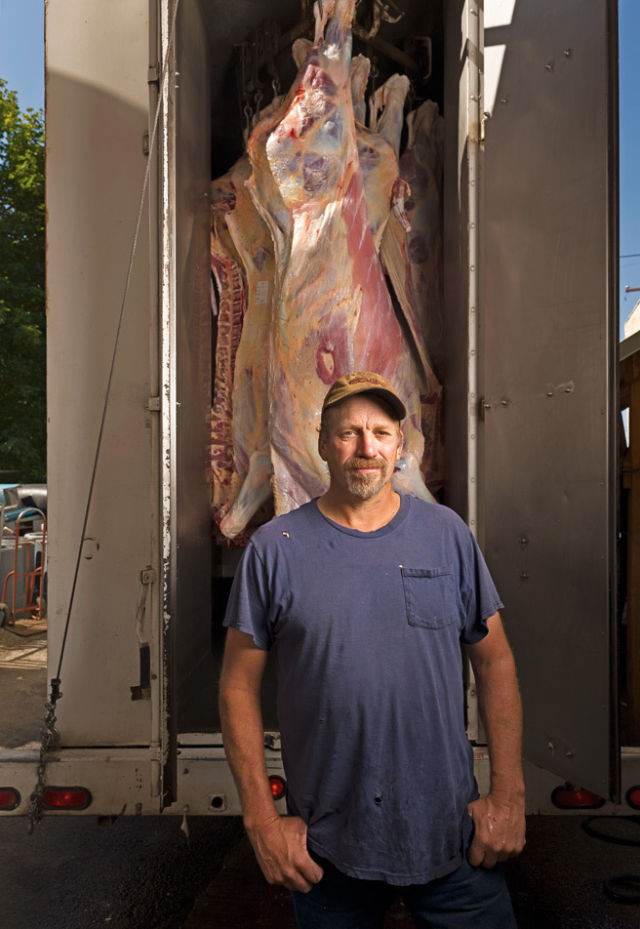
Dale Baker slaughters the cattle on the ranch, sparing them unnecessary stress in transit to a slaughterhouse.
Image: Daniel Root
To serve her larger-volume clients like OHSU, Carman faced a challenge of a different kind: finding a USDA-inspected slaughterhouse that would take her relatively modest business. As the meat industry has consolidated over the past 30 years, many of the smaller regional USDA-certified facilities have closed or been bought up by industrial-size processors like Cargill or Tyson. Oregon has just 13 USDA-inspected slaughterhouses left, only three of which are east of the Cascades. According to Oregon Rural Action, many Eastern Oregon ranchers must truck their cattle more than 150 miles one way just to get them butchered.
The big slaughterhouses process enormous volume—3,000-plus cattle per day. At the height of “harvest” season in October and November, Carman Ranch won’t do more than 25 cattle a week, a volume that left her calls to the larger slaughterhouses unreturned at first. She ultimately partnered with another small family ranch to work with Fulton, a Sysco-owned meat distributor that processes animals for other sustainably minded companies such as Oregon’s Country Natural Beef and Painted Hills Natural Beef. The arrangement has allowed Carman to expand the number of cattle in her wholesale program to a more profitable 300 a year.
For grass-fed beef in general, the marketplace is still in its Wild West phase of experiments small and large. When the Country Natural Beef co-op was founded in 1986, for instance, it was among the first in the country to forbid antibiotics and growth hormones. In 2000, CNB started experimenting with the method, too. Five years later (roughly when Carman had just begun her grass-fed program), New Seasons CEO Brian Rohter was clamoring for more of CNB’s grass-fed product. The co-op now supplies New Seasons with 16 grass-fed cows a week; the resulting ground beef and steaks are branded under the “Pacific Village” label to distinguish it from CNB’s other lines. “The beef comes into the store on a Wednesday, and by Saturday, it’s gone,” says CNB’s Kathy Panner, who originated the grass-fed program. But the Pacific Village line still constitutes less than 3 percent of the co-op’s gross sales. Among the other small to medium grass-fed operations like Carman Ranch are Afton Field Farm in Corvallis, Full of Life Farm in St. Paul, and Silvies Valley Ranch in Grant County, south of John Day. Even Painted Hills, in Central Oregon, which has been producing “natural” (though corn-finished) beef since 1997, is getting in on the act. In August, the company launched its own line of grass-finished beef, starting with 140 cattle.The big slaughterhouses process enormous volume—3,000-plus cattle per day. At the height of “harvest” season in October and November, Carman Ranch won’t do more than 25 cattle a week, a volume that left her calls to the larger slaughterhouses unreturned at first. She ultimately partnered with another small family ranch to work with Fulton, a Sysco-owned meat distributor that processes animals for other sustainably minded companies such as Oregon’s Country Natural Beef and Painted Hills Natural Beef. The arrangement has allowed Carman to expand the number of cattle in her wholesale program to a more profitable 300 a year.
When it comes to taste, grass-fed is not always what mainstream diners—or chefs—want. American eaters are famous for loving juicy marbled steaks, while grass-fed steak has long had the unfortunate reputation of tasting gamey and tough. And, not surprisingly, Portland’s top chefs are on a constant quest for perfection. At one of Portland’s premier steak houses, Urban Farmer, chef Matt Christianson has experimented with a few grass-fed products, most recently veterinarian-turned-rancher Scott Campbell’s Silvies Valley Ranch yearling beef, known as “vittelone.” Christianson says the beef, slaughtered at the tender age of 12 months, has a subtle taste and is “the purest grass-fed beef I’ve tried.” But his customers overwhelmingly prefer steaks from Scio-based Highland Oak, where the cows eat grass until their last four months, when they are then finished on a mixture of corn, alfalfa, and flaxseed oil combined with the pasture grass.
Vitaly Paley, Iron Chef winner and co-owner of Paley’s Place, recalls his first experiments with a local ranch’s grass-fed steak five years ago “The first time we got them, it was OK. The second time, the steaks were small, and very inconsistent,” says Paley. His customers often sent them back.
Toughness and variability, according to Country Natural’s Panner, are caused by improper grazing management. “If you have pasture that will provide enough nutrition so that they can gain 2.5 pounds a day, that beef will be good-tasting,” she says. “But if you have pasture that is dry and cattle that are only gaining a pound a day, then that meat will taste like shoe leather.”
Carman’s achievement, at least to the chefs whose loyalty she has won, is so far singular: pure grass-fed beef in which the taste and texture is consistent enough for the picky, high-end diner. While Carman says she’s “still learning,” she attributes her success to two methods: moving the cattle between pastures in a careful process known as rotational grazing, which ensures that the animals get their needed nutrients while adding plenty of fat; and the dry-aging of her beef for at least 12 days, which adds tenderness and imparts a nutty, cheesy accent that Paley, for one, associates with a fine prosciutto.
“You can’t describe it in a conventional beefy sense,” he says. “Those terms—beefy, fatty, gamey, marbled—they don’t apply. The flavor is a little more focused, clean, grassy. It has that green pasture to it.” Though he could serve Carman Ranch beef year-round, freezing the steaks and then thawing them as needed (as does another convert, Greg Perrault at June), Paley chooses not to. “I like the fact that we can do this seasonal thing with beef, he says. “It’s like you’re rediscovering the first strawberry of the season.”
AT THE CARMAN Ranch drop-off in July, the three brawny men—Lucian Baker, William Pickard, and Shawn Piper—tick off their reasons for buying grass-fed beef. Pickard, a semiconductor technician, lauds the meat’s higher amounts of “good fats”—conjugated linoleic acid, an anticarcinogen. Baker, another technician, finds solace in the greater safety of pasturing cows—a corn-fed diet gives cattle an acidic gut, making them more susceptible to E. coli. Piper, a designer at a technology start-up, cites Lierre Keith’s The Vegetarian Myth, which argues that eating grass-fed beef helps the planet more than eschewing meat altogether because the cows actually rebuild the topsoil. Pickard and Piper are also adherents of the “paleo diet,” a strict regimen of foods our paleolithic ancestors would have eaten, namely pastured meat, vegetables, fruits, and nuts.
Caveman-diet faddists, Michael Pollan acolytes, health nuts and foodies have caused grass-fed beef to “explode”—averaging more than 100 percent market growth annually—says Allen R. Williams, a Mississippi-based food industry consultant who specializes in grass-fed and organic beef. Yet it still makes up only 2 percent of the US beef market. Most experts agree that there’s a lot more room for growth. “We actually have quite a bit of grassland available out there. The key is knowing how to utilize it properly,” says Williams. Graham Meriwether, the director and producer of a new documentary called American Meat, agrees. He has calculated that the US would need about 193 million acres of land converted to grass-based ranching to feed our current appetite for beef (an average of 60 pounds per person, annually). According to USDA statistics, the country has over 1 billion acres of pasture and farmland—it’s just that currently much of that land is devoted to corn and soybeans.
Carman’s professor from Stanford, Wally Falcon—now 75 and retired, but still very much keeping his eye on the world’s food production—puts the fate of grass-fed beef succinctly. “There’ll be specialized ranches producing for upper-income groups,” he says. With corn prices skyrocketing—and commodity beef prices at an all-time high as a result—what Falcon calls the “bottom billion” may not be able to afford any beef at all.
The rising price of beef, in some ways, is good news for Carman Ranch. “If you look at our little world, where we’re committed to raising animals this way, it’s great,” Carman says. But while the ranch is blissfully unaffected by rising corn prices, market surges squeeze in other ways: for instance, the cost of calves. And, so, like the efforts of four previous generations who have operated the ranch, her new-old way of raising beef—along with her idealism—faces the age-old search for profit.
Set on charging her customers only what it costs to produce her meat plus a margin to support her family, Carman says she has no plans to raise her prices, at least not more than a few percent per year. Instead, as she continues to scale up, she’s focusing on improving efficiencies like switching to a big cattle truck instead of a trailer to save $30 an animal—an annual savings of $21,000.
“Our family is not going on a vacation for the next several years,” she says. “Last year, we finally got a savings account.”




